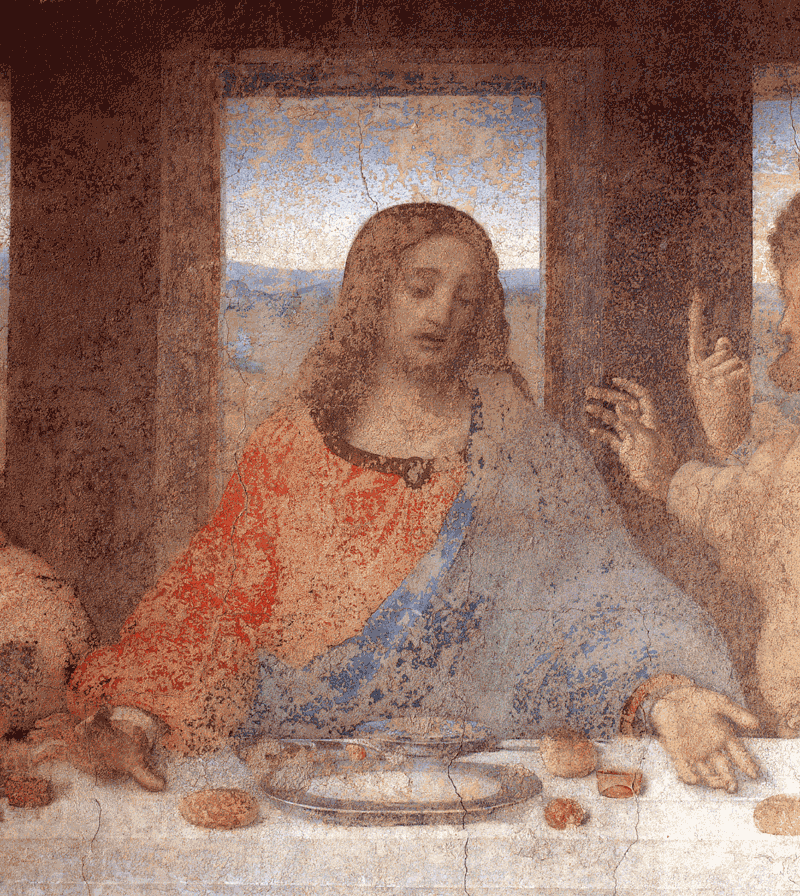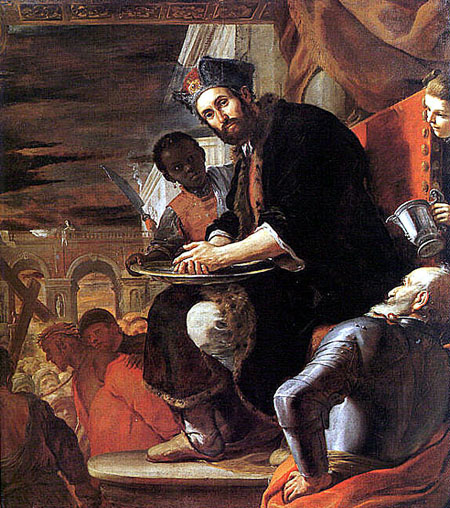The earliest mention of an object referred to as the Holy Grail is Percival, the Story of the Holy Grail, written by Chrétien de Troyes between 1150 and 1190.
The grail appears in a procession watched by the "youth" (Perceval the Welsh) in the Castle of the Fisher King.
While they were talking of one thing and another, a youth came from a chamber, who held a white lance grasped by the middle, and he passed between the fire and those who were sitting on the couch. All those who therein saw the white lance and the white iron, and there issued from the iron of the lance a drop of blood, and that vermilion drop of blood flowed as far as the hand of the youth.
...
Now two other youths came, holding in their hands candelabra of fine gold, worked in niello. The youths who were bringing the candelabra were very handsome. On each candelabrum were ten candles burning at the very least. A fair and gentle and well attired damsel, who came with the youths, was holding a grail between her two hands. When she entered therein with the grail that she held, so great a brightness came there that the candles lost their light, just as do the stars when the sun rises, or the moon. After her came another damsel, who held a silver tray. The grail, which went before, was of fine refined gold; there were precious stones on the grail of many kinds, of the richest and the dearest there are on land or sea; those of the grail surpassed all other stones without a doubt. Just as the lance passed before the couch, they passed by it and entered from one chamber into another.
The youth saw them pass, and did not dare ask of the grail whom one served with it...
...
Meanwhile the grail passed by in front of them again and the youth did not ask of the grail whom one served with it
...
But he keeps silent more than is fitting, for at each dish which was served he see the grail completely uncovered pass in front of him
Later, he is quizzed by a maiden
"Did you see the grail?"
"Yes, indeed."
"Who was holding it?"
"A maiden."
Later in the story, he is again asked about the grail
And of the grail that you saw you did not ask nor did you inquire what noble man was served with it.
At another point, it is explained by Perceval's uncle that it is the Fisher King "who has himself served with the grail." The speaker then adds
But do not believe that he has pike nor lampreys nor salmon; with a single host, which is carried to him in this grail, the holy man sustains and comforts his life. So holy a thing is the grail, and he is so spiritual that to his life nothing more is needed than the host which comes in the grail
Because of the failure of the "youth" to ask "whom one served with" the grail, the Fisher King dies.
Chrétien de Troyes's story is left incomplete, and little more is learned about the grail in the remaining portion. Many theories have been put forward attempting to explain what the grail is.
The most popular interpretation is that the grail is the vessel in which Joseph of Arimathea collected the Sacred Blood of Christ when he was taken down from the cross.
The lance is identified as the weapon of Longinus, the Roman centurion who pierced Christ's side with it when he was on the cross. The lance of Longinus has for centuries been one of the four most sacred relics in possession of the Vatican.
Later Grail Stories
Another version of the Grail Story is found in a 3,514-line poem by Robert de Boron called Joseph of Arimathie or The Romance of the Seint Graal or Holy Grail, written between 1191 and 1201.
The grail is identified as the Cup used at the Last Supper, and in which Christ's blood was collected after the crucifixion. The Cup or Grail was subsequently taken by Joseph of Arimathea and his relatives to England.
Parzifal was written by Wolfram von Eschenbach between 1195 and 1210. In this version, the grail is a miraculous stone which prevents death and sustains life through food and drink.
However, despite the late Judaeo-Christian identification of the grail as a cup or chalice, it remains unclear what sort of "vessel" it was originally.
In early texts, the word, usually encountered without the prefix Seynt, Seint, Saint, Sainct, or San, is spelled variously in Norman-French, Provençal, Old Catalan, Old Spanish, modern French, and Old English as
- Graal
- Greal
- Graaus
- Grasal
- Grazal
- Grazaus
- Grisal
- Grial
- Graal
- Grëal
- Gréal
- Graile
- Grayle
These terms variously describe large dishes, large round shallow bowls, basins, or pots.
The original sense of graal, therefore, was a bowl or dish, and the Holy Grail was the Holy Dish which was used at the Last Supper:

Leonardo da Vinci, Last Supper, 1498 (detail)
According to non-canonical stories, the Holy Dish was subsequently stolen by a servant of Pilate and used by Pilate to wash his hands in:

Mattia Preti, Pilate Washing his Hands, 1663
Later it was given by Pilate to Joseph of Arimathea as a memorial of Christ, and finally used by Joseph to collect the Holy Blood of Christ flowing from his five wounds.
However, even in the 12th century, the holy dish was replaced in stories by a cup or chalice. The words san greal lost their original meaning ("holy dish") and were turned into sang real and interpreted as meaning "real blood" (although, as a French phrase, the word real would mean "royal," and thus "royal blood").
|

